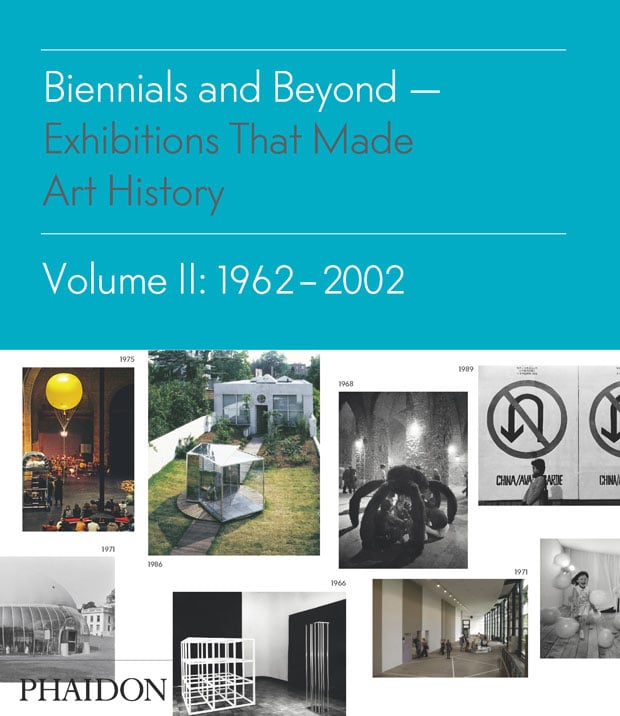
Book Review: Biennials and Beyond – Exhibitions that made Art History, 1962-2002
Rosie Cooper says ‘Biennials and Beyond’ is a vital book that has landed in a world full of curators.
J. Crew’s ‘New curator pant’ is expensive, and currently sold out because it is so popular. It is a tapered, elegant trouser in a thick jersey. The J. Crew website itself has made a space in the sidebar, inviting me to choose from a selection of shoes, trousers and a rather bland cardigan, based on my search. Presumably this is done by some kind of trouser-wearing curator robot, which sounds stylish, but in my experience this type of robot will often get it wrong, and in any case, having learned from the plight of the supermarket cashier, I don’t want one to take my job.
In recent years, the term ‘curator’ has fallen into common parlance. We are everywhere: in trousers, on MA courses, choosing things, all over the world. From the notion of the museum curator as the caretaker of objects, modern questions about the collection and display of art in the world has given the profession a different emphasis: the contemporary curator is an active thinker, transforming from time to time into artist, critic or philosopher. It is an extremely competitive profession, and if you do it, you have to prove that you are especially brilliant and unique, all the time. By and large, I tend to agree with Maria Lind, who, in a recent article in Art Review, called for curators to stop obsessing over their own methodologies, their brilliant and unique “curatorial pirouettes”, and to focus their attention on artists, and their art – “how it sits in a specific situation in society, and how it operates from there.”
Bruce Altshuler’s sturdy book ‘Biennials and Beyond – Exhibitions That Made Art History, 1962-2002’ brings important attention to what exhibitions and their makers can really do. It is a vital read, especially if you are fed up to the back teeth with all those bloody curators everywhere and have forgotten what on earth it is that they are supposed to do anyway. It is also a refreshing reminder for everyone that the practice of exhibition making is usually a joint effort. The exhibitions that Altshuler includes are made by curators, but also by artists, philosophers and gallerists, working alone and together, and always producing something that emerges out of research and conversation. Using photographic records, excerpts from catalogue essays and contemporary critical responses, the book brings together 25 canonical exhibitions, presenting them in the context of an art history that quickly relates to the socio-political conditions in which art was being produced.
The classics are all here: proto-star-curator Harald Szeeman’s ‘When Attitudes Become Form’ (Bern, 1969), as well as his iteration of Documenta in 1972. Curator/ Gallerist Seth Sieglaub’s conceptual ‘January 5-31, 1969’ (New York, 1969) which consisted largely of a publication, is represented; as is artist Damien Hirst’s YBA-maker ‘Freeze’ (London, 1988), and my old favourite ‘Chambres d’Amis’ (Ghent, 1981), a rambling exhibition which occupied a series of private homes throughout the City. These exhibitions presented the newest art practice, whilst simultaneously working out how best to show it to the public; but Altshuler also chooses exhibitions that highlight broader problems. ‘The Bulldozer Exhibition’ (Moscow, 1974) is a devastating account of artists attempting to stage an exhibition of their work without the state’s permission. The title refers to what happened. Projects such as ‘The Times Square Show’ (New York, 1980) and the Second Havana Biennial (1986) posed a direct challenge to the dominance of the white Western male as he loomed over art history and the art market, in the face of globalisation and struggles for gender and racial equality. This necessity can be seen, for example, in the artist list for ‘A New Spirit in Painting’ (London, 1981), which was an important attempt to reinvigorate debate about painting in the age of conceptualism: with an all-male cast.
Within Althshuler’s selection, it is difficult to find an exhibition that doesn’t in some way attempt to grapple with how one might live and make art in the present. Philosopher Jean-Francois Lyotard, best known for his theories on postmodernism, and design historian/ theorist Thierry Chaput, mounted their extraordinary project ‘Les Immateriaux’ (Paris, 1985) as a way of investigating how new technologies might alter ideas around objecthood and the self. This exhibition was the first to involve a philosopher in such a central way. It included holograms, personal computers and 3D cinema alongside a selection of art objects. Mary Jane Jacob’s ‘Places With a Past’ (Charleston, 1991) took on the difficult task of presenting socially engaged practice in an exhibition context; and Hou Hanrou, with Hans Ulrich Obrist, made ‘Cities on the Move’ (various locations, 1998), looking at globalisation and the hyper-growth of Asian cities.
Making an exhibition is a way to tell a story. It is a way of introducing art to, and positioning it in, the world. When it’s done properly, the results can be fantastic, as this book proves. If you don’t want to be caught with your curator-pants down, I recommend that you read it.
Join the Discussion
You must be logged in to post a comment.